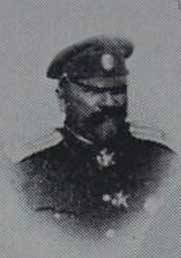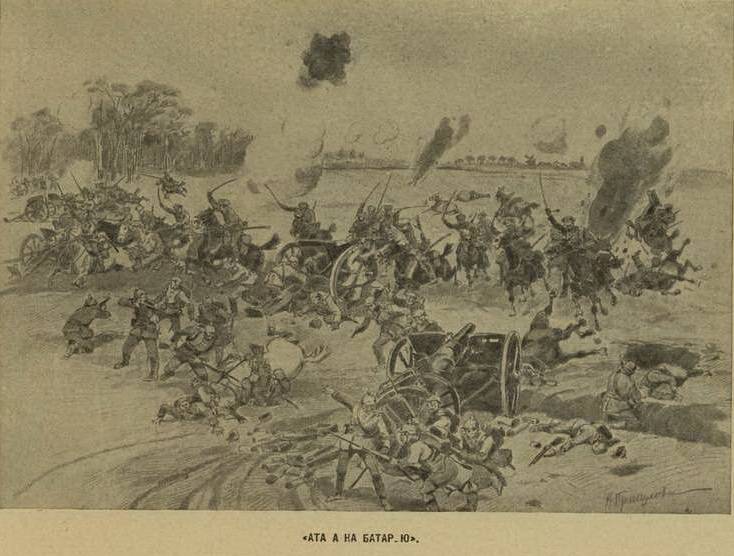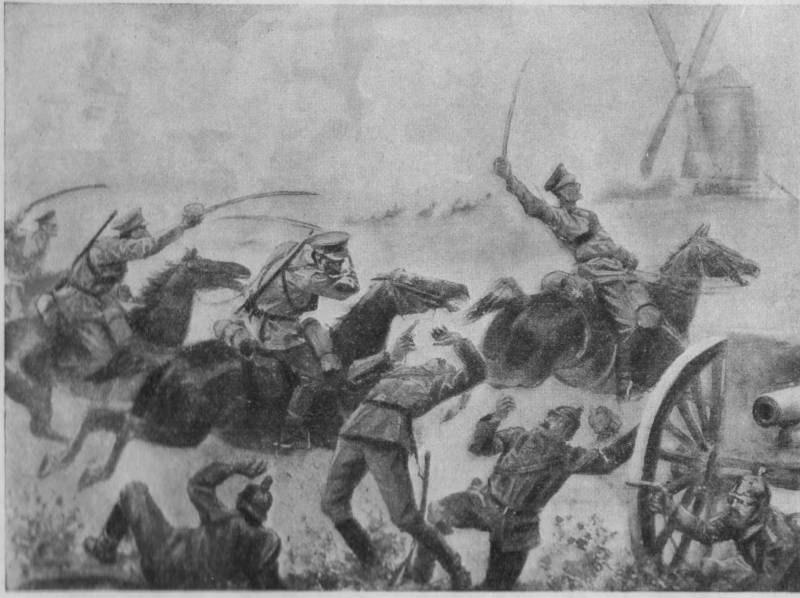Three Nizhny Novgorod attacks. Part of 2. Heavy battery
Events developed as follows.
10. 11. The 1914 r. Regiment was alarmed. The order indicated: 4-mu and 6-mu squadrons to dismount, go over the railway near the Kolushki station and, then, move forward and stop at the stone building. There, on returning from the guard, the 5 squadron should have come. 1-th, 2-th and 3-th squadrons under the command of Lieutenant Colonel S. Yu. Yagmin, was ordered to move along the railway line - to protect the left flank.
Shrapnels began to burst over the 2-th squadron chain and the squadron was ordered to withdraw, while the 3 squadron was tasked with advancing along the railway line to Petrokov - to monitor and guard the left flank.
At this time, near Lodz, the Russian 2 army was fighting off the Germans surrounding it from three sides. But the Russian command counter-maneuver did the job - and the German shock group (the core - the 25-th reserve corps) itself got into the boiler. Part of the latter, escaping from the encirclement, entered into oncoming battles with parts of the Lovičsky detachment advancing from the north and the Caucasus cavalry division advancing from the northeast. The attack of Nizhny Novgorod 10 November and became one of the episodes of the battle with the latter.
The 4 and 6 squadrons, crossing the railroad behind the Kolushki station, dismounted, awaiting further orders. After leaving the 1 Division to guard the left flank, Captain Kosarev, who temporarily handed over the 6 squadron to the Staff Captain Prince Kazanalipov and commanded the 2 Battalion on that day, ordered the 4 and 6 squadrons with machine guns to promote the squadrons with the advance squadron to advance the battalions of the fleet. about a kilometer, and located on the outskirts of the village Zakovets.
The weather was cold and the plow was slightly frozen; the morning fog began to dissipate. After some time, the 4-th and 6-th squadrons were joined by a half-squadron of the 5-th squadron with the commander captain Chavchavadze and the cornet prince Chhotua.
An oral order was received by N. L. Melikov: “In view of the fact that our artillery successfully fired at the enemy’s artillery and even managed to bring down one weapon, the regiment commander ordered the battery to be attacked immediately.”

N. L. Melikov.
Quickly mounted on horses, squadrons left the village and began to build to attack. At this time, the first echelons of the Russian infantry began to be unloaded at Kolushki station.
Squadrons were built quietly, as on the doctrine: on the right flank of the 4 squadron, then the half squadron of the 5 squadron, and to the left, the 6 squadron. Division commanded, as noted, the captain Kosarev.
The exact direction of the attack was not known, so the squadrons moved at a trot - in the approximate direction of the enemy. As soon as the squadrons began to move, two heavy shells buzzed over them and exploded in the village they had just left. Black smoke sprang up and flames flared. Soon the 6 Squadron passed through a chain of Siberian shooters, seeing off the dragoons with shouts: “Brothers, cavalry - help out!”
Several heavy artillery shells exploded in the ranks of the dragoons, and rifle fire intensified. At this time, Captain Kosarev commanded: “Right shoulder forward. Heading towards the sun! ” Since the entire front of the division could not hear his voices, the order began to be transmitted through the ranks, and Captain Navruzov had to personally ride along the front of his 4 squadron to the right flank to give the squadron the right direction. And the entire line of attackers went into a gallop.
The enemy was not visible. Wrapping up his squadron with his right shoulder, the captain Navruzov also passed the line of the Siberian riflemen, and the company commander excitedly shouted to him - “his own! your, do not chop! ". The cavalry rushing to the infantry made such a strong impression. Having calmed the company commander, Navruzov commanded a "field gallop", and the attacking line rushed on. At the head of the 4 th squadron, Captain Navruzov rode, and in front of the platoons, the cornet was Prince Vachnadze and warrant officers Isaev and Pototsky. Ahead of half-squadron 5-th squadron were Captain Prince Chavchavadze and cornet Chkhotua headed 6-th Squadron - Lieutenant-Captain Prince Kazanalipov and before platoons Lieutenant Prince Andronicus, volunteer Pfel and platoon sergeant Ovcharenko.
As soon as the dragoons rode through the chain of Siberian riflemen, she quickly got up and moved forward — encouraged by such unexpected and impressive reinforcements. Meanwhile, the enemy was still not visible, and the shooting intensified.
Squadrons, despite the strongest fire and sensitive losses, continued to move in great order. In the 4 squadron, the thoroughbred mare of Prince Vachnadze carried him, and he swept past Navruzov, who at that very moment saw the brilliant helmets of the Germans lying in the bushes. When approaching the attackers, some of the Germans threw weaponand the rest were hacked by dragoons.
The captain of Navruzov wanted to detach one platoon to escort the prisoners to the rear, when he suddenly saw in front of him steps in 40 - 50 four huge guns and Germans scurrying around them. Navruzov himself found himself about two Germans with revolvers in their hands. Having hit one with a sword, he himself felt a blow to the elbow, the horse slowed down and the officer lost consciousness. As it turned out, a horse was killed at the time of his injury.
6-th squadron also ran into the bushes on the German infantry, lying in the chain. As the attackers approached, some soldiers stood up, some - defending themselves with a bayonet, and some - raising their hands up. Almost all of them were hacked up and survived only those left to lie down (since it was much harder to get them with a sword). Some of the survivors stood up and, turning, shot at the cavalry lava rushing through them. According to the volunteer Pfel, after the attack of the German infantry, he drove into the clearing and, stopping, saw the following picture: to his right, steps in 40, stood a heavy weapon, from which the Germans pursued by the 1 platoon dragoons, and to the left, in the dredging, charging boxes and carts were moving around, trying to either get to the opposite side or run along the canvas. As the dragoons approached, the gunners, the 50 man, rushed to the opposite edge of the recess, bordered by pine young, and opened heavy fire from rifles and revolvers.
Having asked the dragoon where the officers were and received the answer that everyone was killed (and at that moment Prince Andronikov’s horse flew past him), Pfel gathered about twenty dragoons and, through a recess and a wagon train, rushed into the attack on the shooting Germans - and most of the latter were chopped up. Then, having left on the big glade, he saw the captain Kosarev with the 3-th platoon fighters gathered near him.
Having received an order to take several dragoons, find Lieutenant Colonel Yagmin and find out the situation, Pfel, passing through the forest, found a lieutenant colonel with His Majesty's squadron - who was preparing to attack the German convoy. Above the forest, where lieutenant colonel Yagmin stood, enemy grenades began to explode.
Captain Kosarev, gathering the remaining dragoons of the 6 squadron, moved in the direction of the regimental headquarters, taking with them the captured German boxes and wagons. The repulsed German guns were subsequently also evacuated.
Returning, the 6 th squadron met the reconnaissance squadron of the 5 th Dragoon Kargopol Regiment, and then the 1 th division of Nizhny Novgorod.
5-th squadron attacked in the center between 4-m and 6-m squadrons, and the captain Prince Chavchavadze was wounded at the moment when he tried to take out the German guns.

Of the ten officers of the 2 division, one captain Kosarev survived. Lt. Col. Yagmin was injured. In 4, the squadron killed: Ensign Pototsky and Isaev 2 and the captain of Navruzov and Cornet Prince Vachnadze were injured. The latter was wounded in the lower abdomen - fell and lost consciousness. He woke up already in the captivity of the Germans - among Siberians. There, they made a bandage for him, and the next morning, when the Germans withdrew from the Russian units, he was released and subsequently sent to the Empress Alexandra Feodorovna Infirmary's Infirmary. From 112 the dragoons survived 37. In 5, the squadron killed the cornet Prince Chkhotu 2, wounded the captain Prince Chavchavadze and wounded the staff captain Prince Chhotua 1. The dragoon was out of action (in three platoons) - 12 killed and 30 wounded. In 6, the squadron killed: Staff Captain Prince Kazananipov and Lieutenant Prince Andronikov, and the dragoon remained in the ranks in three platoons of 27 people. Prince Andronikov, whose horse was killed during the attack, fought long on foot with the Germans who surrounded him - until the heroic death of a German cannon was lost.
It is interesting to quote excerpts from the German description of the November 10 battle:
“In 7 hours. 30 m. In the morning, the vanguard 49 of the reserve division XXV of the reserve corps passed through the railway track to the southeast of Galkov. Hellfire, directed from the front, right and left and from the left side of the rear, forced the infantry to turn around.
Whistling lashes swept across worn-out horses, batteries rattled along railroad tracks at a gallop and stood in a position at the height of 229, directly behind the infantry. At the same instant, the first shots fired at the masses of the enemy infantry at the Galkovek farm and at the Russian batteries still standing there, taken completely by surprise. The dense masses who attacked from there and from Spanovich were broken by this fire and the fire of the heavy howitzer battery of Major Anger, which stood right and behind the field artillery. But wave after wave, from the east, west and from behind, as well as from the north, the earthen-colored figures threw themselves bravely, on all sides at once, the defending part. Not one artilleryman fell victim to a flank machine-gun fire from a locomotive coming up from Kolushk. Three shots made him move away. Then, north of the railway, a wave of Russian dragoons rushed out of the forest into the flank and rear of the vanguard. More than half of the riders fell from the 2 th and 11 th mouth of the 227 regiment, but still more than a hundred sabers whistled over the heads of the gunners, especially over the heavy battery. Then the wave spread over the railway track, rushed to the front and light carriage columns and swirled them in a general whirlwind. She moved galloping further, to the divisional headquarters, located in 400 meters from the railway. Lieutenant-General von-Wenker, together with his officers of the General Staff, quickly assembled a detachment of people of all kinds of weapons: chiefs of artillery columns, officers of the corps headquarters, telegraph operators and telephonists, cyclists of the main command. Many riders died in a collision with them. At least one dragoon has returned from a dashing attack. ”
From this description, it is clear that Nizhny Novgorod attacked Major Anger's heavy howitzer battery and the 2 th and 11 th company of the 227 th infantry reserve regiment covering it.
Evaluating the 10 battle of November, the following should be noted:
1. The complete ignorance of divisional and squadron commanders with the situation - which made it very difficult for the orientation and the adoption of necessary decisions. It was necessary to make independent decisions, guided only by the immediate situation, apart from the general state of affairs. The 1 Division was not notified of the attack of the 2 Division. Knowing about the attack, he could support it with actions to the flank of the enemy attacked by the 2 division.
2. Inexplicably inaction of other regiments of the Caucasian cavalry and 5-th cavalry divisions located near the attack area. It must be assumed that the use of a whole cavalry corps to support or, at least, to further develop the attack, could lead to tremendous results - perhaps the complete defeat of the erupting group of the German 9 Army.
The regiment's awards for the 10 November case were: the Order of St. George of the 4 degree to the captain Prince Chavchavadze and Navruzov and (posthumously) the lieutenant Prince Andronikov. St. George’s weapons have been granted to Lieutenant Colonel Yagmin, Captain Kosarev, Staff Captain Prince Chhotua and Cornet Prince Vachnadze. Captain Den presented to the production of lieutenant colonels - for the difference.
Thus, the attack in the cavalry formation under the Kolushky proved successful - and as noted by the Soviet military historian GK Korolkov: “a part of the German [infant] infantry was hacked and crumpled, a heavy battery was seized at the northern outskirts of Borovo, and the Germans were stunned surprise, for a considerable time weakened their onslaught. " Having mastered the 4 heavy weapons, the valiant regiment lost officers to the fallen 5. But the dragoons rescued their infantry - seeing the enemy units of the 49 th reserve division breaking through from the encirclement, they attacked the latter in equestrian formation.
From the German front, the 17 th Dragoon Nizhny Novgorod Regiment was transferred to the Caucasian Front, operating as part of the Expeditionary Force in Persia.
But the three attacks on the German front became the most glorious page in the regimental chronicles of the glorious Nizhny Novgorod during the Great War - becoming a worthy continuation of the actions of heroic ancestors.

Information